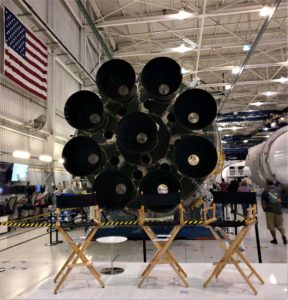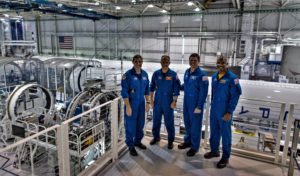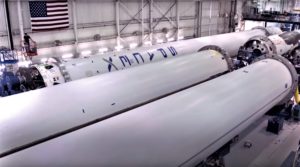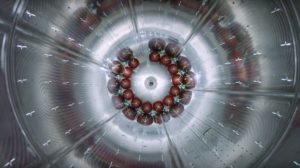
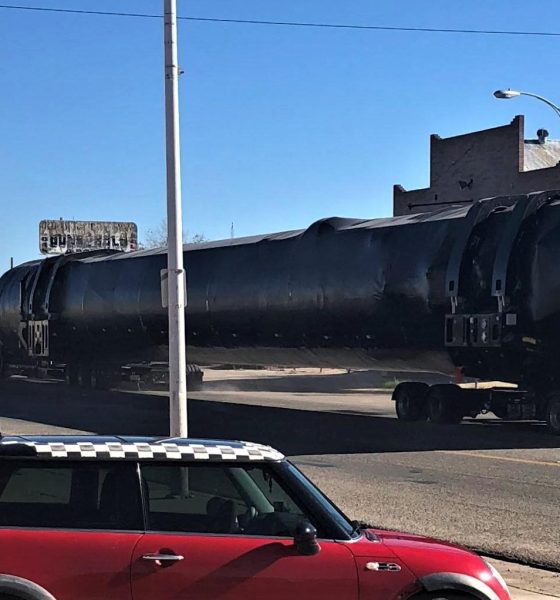
SpaceX
SpaceX hot-fires Crew Dragon’s Falcon 9 as separate rocket spied in Arizona
A SpaceX Falcon 9 booster has been spotted traveling eastbound through Wilcox, AZ, indicating a shipment from the company’s Hawthorne, CA rocket factory to its McGregor, TX facilities for hot-fire acceptance testing.
Captured by Reddit user codercotton on October 28th, this first stage (S1) is headed to Texas at the same time as SpaceX’s facilities appear to be wrapping up an extended test campaign with the Falcon 9 rocket stages that will launch an uncrewed Crew Dragon on the upgraded spacecraft’s first trip into orbit.
The team at our rocket development facility in McGregor, Texas completed a static fire test last night of the Falcon 9 booster that will launch SpaceX’s first demonstration mission for @NASA’s Commercial Crew Program – one step closer to flying astronauts to the @Space_Station! pic.twitter.com/iDYNoamCvU
— SpaceX (@SpaceX) October 27, 2018
This duo of Falcon 9 appearances highlights an unusual few months of what is often called “core spotting” by close followers of SpaceX. Typically, SpaceX ships and hot-fire tests a Falcon 9 booster every month, give or take roughly two weeks. It’s clear, however, that the imminent start of Crew Dragon launches under NASA’s Commercial Crew Program (CCP) has created some unique requirements with respect to both booster, upper stage, and individual engine testing in Texas.
For example, Falcon 9 B1051 – a new booster assigned to Crew Dragon’s first uncrewed demonstration launch (DM-1) – appears to have been testing in McGregor for the better part of three months, apparently including multiple hot-fire tests of the rocket. Prior to Commercial Crew, a nominal round of acceptance testing in McGregor would be expected to last between two and four weeks between arrival and departure. As such, spending three months or more in McGregor is very unusual, particularly for a brand-new booster like B1051.
B1051’s extended period of testing can likely be traced back to two main factors. At a more technical level, B1051 could be the first Falcon 9 Block 5 booster to have SpaceX’s upgraded COPVs (carbon-overwrapped pressure vessels) – bottles designed to hold helium and nitrogen at pressures around 5000 psi (35 MPa) – fully integrated on both the first and second stages. Perhaps not a major technical hurdle for SpaceX, this milestone is undoubtedly one of NASA’s most myopic and obsessive mountains-out-of-molehills in terms of the intense ‘certification’ burdens dumped on SpaceX over the course of CCP. SpaceX has apparently spent at least 1.5 years systematically designing, testing to destruction, and redesigning an in-house COPV, to the extent that CEO Elon Musk described the updated design as “by far the most advanced pressure vessel ever developed by humanity … It’s nuts.”
- In mid-September, CEO Elon Musk presented an update to BFR in front of Falcon 9 B1054 and at least three other visible boosters. (Eric Ralph)
- SpaceX’s NASA astronauts pose in front of the main Falcon assembly line, September 2018. (SpaceX)
- An October 2018 NASA video included this brief glimpse of SpaceX’s assembly line. (SpaceX)
- Falcon 9 shows off some of its COPVs in a tour of SpaceX’s Hawthorne factory. (SpaceX)
Juggling Falcon 9 tests
Despite the extreme lengths of testing apparently required for the Falcon 9s that will launch Crew Dragon, it can be concluded with some certainty that SpaceX has still managed to fit in normal tests of a number of non-Crew boosters, upper stages, and Merlins. According to the above SpaceX tweet, B1051 is clearly still in Texas and is unlikely to leave for Florida until November (several days are needed to prepare a booster for transport). However, a different booster was spotted heading from California to Texas just this morning.
Further, Falcon 9 booster B1054 – nearly complete and stationed in front of the only real exit route – was spotted in SpaceX’s Hawthorne factory in mid-September, while an unknown first stage was caught departing the factory for Texas roughly two weeks later. Finally, at the same time as the mystery booster was being trucked to Texas, an even more mysterious Falcon 9 – visibly sooty and thus flight-proven – was spotted inside one of SpaceX Hawthorne’s separate refurbishment hangars, with at least three Merlins removed from its octaweb. Perhaps this is somehow related to the Falcon 9 booster (missing four of nine Merlins) headed East on October 28th.
Finally, according to a member of the /r/SpaceX subreddit, a separate Falcon 9 booster apparently arrived at SpaceX’s Vandenberg, CA launch facilities on October 26th, perhaps Falcon 9 B1046.3 preparing to launch for the third time for Spaceflight’s SSO-A rideshare mission, NET November 19.
https://twitter.com/_TomCross_/status/1048483536917823488
As with most things SpaceX, definitive answers are exceedingly rare when it comes to day-to-day operations like Falcon 9 transportation and even official confirmation of the particular boosters involved with any given launch. Understandably, these more esoteric details are probably treated as “need-to-know” only, and while I and many others would love to know, we certainly don’t *need* to know.
For prompt updates, on-the-ground perspectives, and unique glimpses of SpaceX’s rocket recovery fleet check out our brand new LaunchPad and LandingZone newsletters!

News
SpaceX shades airline for seeking contract with Amazon’s Starlink rival

SpaceX employees, including its CEO Elon Musk, shaded American Airlines on social media this past weekend due to the company’s reported talks with Amazon’s Starlink rival, Leo.
Starlink has been adopted by several airlines, including United Airlines, Qatar Airways, Hawaiian Airlines, WestJet, Air France, airBaltic, and others. It has gained notoriety as an extremely solid, dependable, and reliable option for airline travel, as traditional options frequently cause users to lose connection to the internet.
Many airlines have made the switch, while others continue to mull the options available to them. American Airlines is one of them.
A report from Bloomberg indicates the airline is thinking of going with a Starlink rival owned by Amazon, called Leo. It was previously referred to as Project Kuiper.
American CEO Robert Isom said (via Bloomberg):
“While there’s Starlink, there are other low-Earth-orbit satellite opportunities that we can look at. We’re making sure that American is going to have what our customers need.”
Isom also said American has been in touch with Amazon about installing Leo on its aircraft, but he would not reveal the status of any discussions with the company.
The report caught the attention of Michael Nicolls, the Vice President of Starlink Engineering at SpaceX, who said:
“Only fly on airlines with good connectivity… and only one source of good connectivity at the moment…”
CEO Elon Musk replied to Nicolls by stating that American Airlines risks losing “a lot of customers if their connectivity solution fails.”
American Airlines will lose a lot of customers if their connectivity solution fails
— Elon Musk (@elonmusk) December 14, 2025
There are over 8,000 Starlink satellites in orbit currently, offering internet coverage in over 150 countries and territories globally. SpaceX expands its array of satellites nearly every week with launches from California and Florida, aiming to offer internet access to everyone across the globe.
Currently, the company is focusing on expanding into new markets, such as Africa and Asia.
News
Tesla hints at Starlink integration with recent patent
“By employing polymer blends, some examples enable RF transmission from all the modules to satellites and other communication devices both inside and outside the vehicle.”

Tesla hinted at a potential Starlink internet terminal integration within its vehicles in a recent patent, which describes a vehicle roof assembly with integrated radio frequency (RF) transparency.
The patent, which is Pub. No U.S. 2025/0368267 describes a new vehicle roof that is made of RF-transparent polymer materials, allowing and “facilitating clear communication with external devices and satellites.”
Tesla believes that a new vehicle roof design, comprised of different materials than the standard metallic or glass elements used in cars today, would allow the company to integrate modern vehicular technologies, “particularly those requiring radio frequency transmission and reception.
Tesla has recently filed a US patent application on integrating RF transparent materials into the roof structure.
“facilitating clear communication with external devices and satellites”
Tesla fleet is getting @Starlink connectivity integration soon. LFG @Tesla @elonmusk… pic.twitter.com/bLa8YtPLd1
— Chansoo Byeon (@Chansoo) December 9, 2025
Instead of glass or metallic materials, Tesla says vehicles may benefit from high-strength polymer blends, such as Polycarbonate, Acrylonitrile Butadiene Styrene, or Acrylonitrile Styrene Acrylate.
These materials still provide ideal strength metrics for crashworthiness, stiffness for noise, vibration, and harshness control, and are compliant with head impact regulations.
They would also enable better performance with modern technologies, like internet terminals, which need an uninterrupted signal to satellites for maximum reception. Tesla writes in the patent:
“By employing polymer blends, some examples enable RF transmission from all the modules to satellites and other communication devices both inside and outside the vehicle.”

One of the challenges Tesla seems to be aware of with this type of roof design is the fact that it will still have to enable safety and keep that at the forefront of the design. As you can see in the illustration above, Tesla plans to use four layers to increase safety and rigidity, while also combating noise and vibration.
It notes in the patent that disclosed examples still meet the safety requirements outlined in the Federal Motor Vehicle Safety Standards (FMVSS).
Starlink integrated directly into Tesla vehicles would be a considerable advantage for owners. It would come with a handful of distinct advantages.
Initially, the inclusion of Starlink would completely eliminate cellular dead zones, something that is an issue, especially in rural areas. Starlink would provide connectivity in these remote regions and would ensure uninterrupted service during road trips and off-grid adventures.
It could also be a critical addition for Robotaxi, as it is crucial to have solid and reliable connectivity for remote monitoring and fleet management.
Starlink’s growing constellation, thanks to SpaceX’s routine and frequent launch schedule, will provide secure, stable, and reliable internet connectivity for Tesla vehicles.
Although many owners have already mounted Starlink Mini dishes under their glass roofs for a similar experience, it may be integrated directly into Teslas in the coming years, either as an upgrade or a standard feature.
Investor's Corner
SpaceX IPO is coming, CEO Elon Musk confirms
However, it appears Musk is ready for SpaceX to go public, as Ars Technica Senior Space Editor Eric Berger wrote an op-ed that indicated he thought SpaceX would go public soon. Musk replied, basically confirming it.

Elon Musk confirmed through a post on X that a SpaceX initial public offering (IPO) is on the way after hinting at it several times earlier this year.
It also comes one day after Bloomberg reported that SpaceX was aiming for a valuation of $1.5 trillion, adding that it wanted to raise $30 billion.
Musk has been transparent for most of the year that he wanted to try to figure out a way to get Tesla shareholders to invest in SpaceX, giving them access to the stock.
He has also recognized the issues of having a public stock, like litigation exposure, quarterly reporting pressures, and other inconveniences.
However, it appears Musk is ready for SpaceX to go public, as Ars Technica Senior Space Editor Eric Berger wrote an op-ed that indicated he thought SpaceX would go public soon.
Musk replied, basically confirming it:
As usual, Eric is accurate
— Elon Musk (@elonmusk) December 10, 2025
Berger believes the IPO would help support the need for $30 billion or more in capital needed to fund AI integration projects, such as space-based data centers and lunar satellite factories. Musk confirmed recently that SpaceX “will be doing” data centers in orbit.
AI appears to be a “key part” of SpaceX getting to Musk, Berger also wrote. When writing about whether or not Optimus is a viable project and product for the company, he says that none of that matters. Musk thinks it is, and that’s all that matters.
It seems like Musk has certainly mulled something this big for a very long time, and the idea of taking SpaceX public is not just likely; it is necessary for the company to get to Mars.
The details of when SpaceX will finally hit that public status are not known. Many of the reports that came out over the past few days indicate it would happen in 2026, so sooner rather than later.
But there are a lot of things on Musk’s plate early next year, especially with Cybercab production, the potential launch of Unsupervised Full Self-Driving, and the Roadster unveiling, all planned for Q1.
